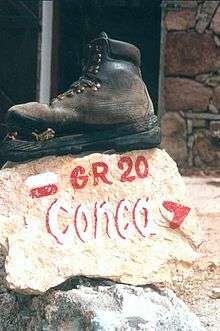GR 20
The GR 20 is one of the extensive Grande Randonnée (or GR) network of paths and trails. The trail traverses Corsica's mountains, with its end points in Calenzana in the north and Conca in the South running most of the length of the island. It is often referred to as "the toughest long distance trail in Europe", covering a distance of 180KM and around 12-13KM of climbing and descent, over rugged terrain.
- This article is an itinerary.
The trail
The trail is normally done in 16 days, however, people often do it in less. It may be walked in either direction, and often in parts, with Vizzavona being an ideal place to start or stop. A few additional refuges exist. Most people prefer to start in the north however starting in the south creates a nice build up in required effort. As you roughly 'cross' seven mountain ranges/ridges when walking the full trail and often close to highest summit of that range, you can relatively easily include these summit visits. Either by taking the GR 20 variante (Aiguilles de Bavella and Monte Renoso) or by climbing the summit from the nearby Bocca's (coll's/passes) crossed by the GR 20 (including Monte Incudine, Monte d'Oro and Monte Cintu). Paglia Orba is a must and good to do starting from Refuge de Ciottulu di i Mori.
- Calenzana
- Refuge d'Ortu di u Piobbu
- Refuge de Carrozzu
- Refuge d'Asco Stagnu
- Refuge de Tighjettu
- Refuge de Ciottulu di i Mori
- Refuge de Manganu
- Refuge de Pietra Piana
- Refuge de l'Onda
- Vizzavona
- Bergeries de Capannelle
- Refuge de Prati
- Refuge d'Usciolu
- Refuge Matalza
- Refuge d'Asinao (burned down in 2014/15 and not yet rebuilt as of 2016. Camping is possible, but there is no food supply, and no hot meal unless you reserved a place in the nearby bergerie)
- Refuge de Paliri
- Conca
Maps
Carte de Randonnée 4149 OT - 4253 OT and 4253 ET (6 maps).
Food
Food can be purchased in most refuges, however they are stocked to varying degrees. In the south of the island below Vizzavona you can often get fresh bread, however you can often get "long life" bread otherwise. You can usually get various supplies such as cheese, saucisson, snack-bars and beer at refuges, with a greater variety at some of the villages and ski resorts en route. Most refuges will supply you an evening meal if you book in time (1 hour before dinner time often works).
Water
There are marked water sources near all of the refuges, and there are the occasional marked sources on route which are safe to drink. Springs dry up in the summer months and there are some long ridges without points of resupply, so it is wise to take out more than 2l of water.
Fuel, cooking and electric power
Most huts have areas with stoves that you can use if you provide your own pans. These can get busy, or sometimes don't work, so if you want to cook your own food it may be a good idea to take a stove along. If you don't mind a few cold meals, not taking a stove will save weight.
- Meths is fairly easy to find in supermarkets, it's sold as cooking alcohol, and won't block Trangias up.
- Screw-top gas canisters are difficult to find however were available in Calvi in 2008.
- Press-top gas is fairly easy to find.
Reloading your battery pack or cell-phone is only possible in village bound refuges.
Camping and refuges
You can stay in most refuges if they're not full, however they can get quite busy. Most if not all huts will provide rentable tents. Camping or as it is referred to "bivouacking" is allowed by refuges all along the route. You can book in and pay the hut guardian when you arrive.
Gear

Take as little as possible, pack light! Keep the weight of your rucksack below 15kg, including 2L of water.
- Rugged boots - you can easily wear out a set of lightweight walking boots on the trail.
- Walking poles (2), you will appreciate these.
- Brimmed hat/sunscreen/long sleeved shirt/pants.
- Light weight wind&waterproof.
- Air mattress (the ground is usually very rocky).
- A tent that will stand without need for pegs (if camping).
General advice
- Walk early, the sun is hottest at midday.
- Snow will mostly be clear by June, so you don't need axe/crampons 'in season'.
- Buses across the island don't run 'out of season', so check your dates. Taxi rides can be expensive.
- Only few refuges give written weather reports, ask the guardian for info.
- Bring cash along. 30 Euro a day will do (about 25 if own cooking, about 35 if using refuge lodging).